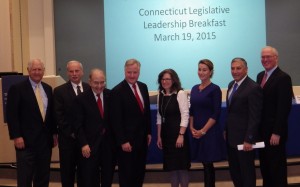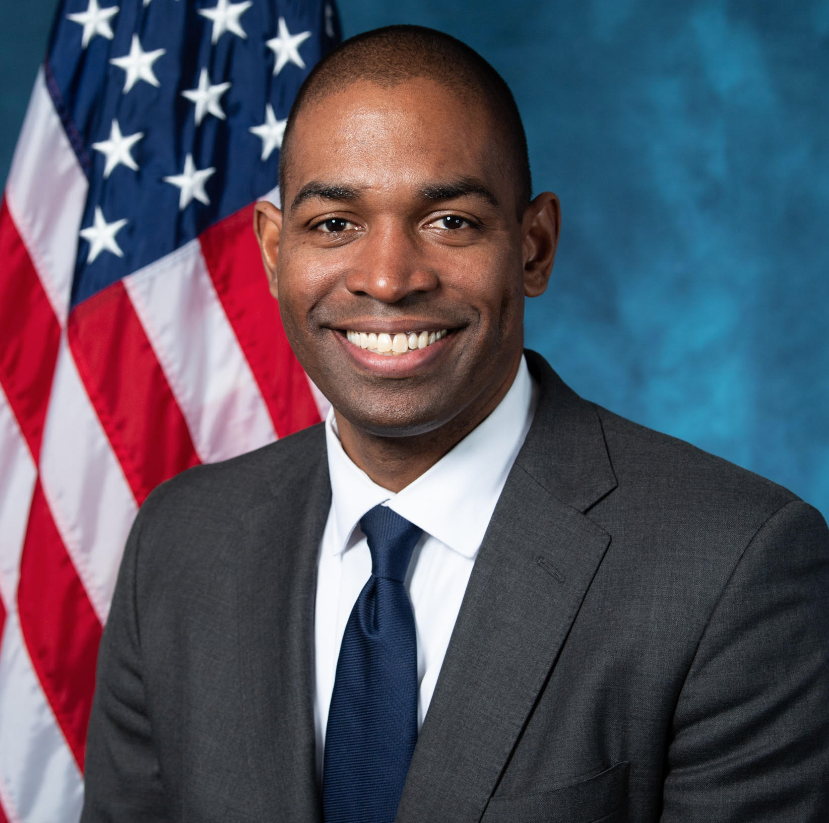Gov. Dannel Malloy”™s proposed $40 billion two-year budget, released in February, provided a springboard for a lively Business Council of Fairfield County-hosted Legislative Leadership Breakfast on Thursday that drew a full-house crowd of legislators and nearly 100 attendees to the conference room of the new Deloitte headquarters in the BLT Financial Centre on East Main Street in Stamford.
The state”™s bicameral leadership ”“ Republicans Len Fasano, Senate minority leader, and Themis Klarides, House of Representatives minority leader, and Democrats Brendan Sharkey, speaker of the House, and Martin Looney, Senate president pro tempore ”“ filled the dais. Joseph McGee, the Business Council”™s vice president for public policy and programs, served as master of ceremonies and peppered the panelists with written questions from the audience.
Topics included revenues ”“ with talk focused on taxes, business incentives and tolls ”“ transportation, education and casinos.

- From left, Darrell Harvey, co-CEO, The Ashforth Co.; Rey Giallongo, chairman and CEO, First County Bank, and board chairman, Business Council of Fairfield County; state Senate President Pro Tempore Martin Looney, D-Hamden, New Haven, North Haven; House Speaker Brendan Sharkey, D-Hamden; Pamela Elkow, partner, Robinson & Cole LLP, and board director and officer, Business Council of Fairfield County; House Minority Leader Themis Klarides, R-Woodbridge, Orange, Derby; Senate Minority Leader Len Fasano, R-Durham, East Haven, North Haven, Wallingford; and Christopher Bruhl, Business Council of Fairfield County president and CEO. Photo by Bill Fallon
The assembled did not dispute the state faces a shortfall, perhaps of $3 billion, over the course of the proposed budget.
Fasano called the budget “a nonstarter,” saying, “We”™re looking to begin from scratch. The systemic problem is we are a business-unfriendly state.
“This is not a Democratic or Republican issue,” he said. “We need to grow the state”™s businesses.” A proposal to up the state”™s borrowing efforts led him to say, “Every businessperson knows that the thing that kills you is the interest, which leads to less money to spend.”
Connecticut”™s debt per resident ”“ at about $5,450 ”“ is the highest in the U.S., according to Moody”™s Investors Service.
Looney has authored the first bill on the Senate docket for the legislative session, a three-part effort that seeks to unify the state”™s car tax ”“ currently about seven times higher for Hartford residents than for Greenwich residents, he said ”“ to provide payments in lieu of taxes for nonprofits and to promote revenue sharing.
Looney cited a Minnesota model for revenue sharing wherein 40 percent of new development money goes into a regional common pool. He called the current Connecticut model akin to “Balkanization,” with 169 towns acting like fiefs “unable to look at things in broader, more comprehensive ways.”
Sharkey, too, addressed the 169-town template, calling it unsustainable and saying, “At the local level we have an incredibly inefficient system.” Change is coming, he said, “And that means goring some oxen along the way.”
Transportation was another pillar of the event. The region”™s transit deficiencies were laid bare anecdotally by Klarides”™ late arrival: stuck in traffic, she said to a sympathetic response from the room.
“Connecticut”™s transportation system is at a critical juncture,” the Business Council said in its four-page “Connecticut Legislative Program 2015” policy presentation that complemented and guided the event. “In February 2014 the Regional Plan Association estimated that the New Haven line requires $3.6 billion in upgrades, including$2.2 billion to replace four railroad bridges that are over 100 years old.”
McGee cited a New Jersey municipality that improved rails and lopped 14 minutes off the commute to Manhattan. That, in turn, led to a 42 percent increase in property values. The Business Council supports rail improvements, saying in its statement, “The creation of a Connecticut high-speed commuter rail transportation system linking Hartford to New Haven to Stamford to New York City in 30-minute travel time increments could be the backbone of Connecticut”™s 21st century economy.”
“A speedier commuting line to New York would be transformational for New Haven,” Looney said.
Klarides said, “No one disagrees with government”™s philosophical proposition of improving transportation.” But she also addressed a popular transportation funding mechanism, saying, “I”™m not a big fan of tolls. I understand they are more efficient today than they were 20, 30 years ago. The problem is that one after another we hear reasons why we need to raise revenue.” She said businesspeople must tighten their belts when revenues decline, but for government, “That is not our first option.”
Sharkey, in turn, pointed out neighboring states use tolls, effectively taxing Connecticut drivers; but Connecticut gives other states”™ drivers a toll-free ride. “Tolls have to be part of the equation,” he said.
The Business Council positions were subtitled, “Investment in Connecticut”™s future must start today.”
An idea for three additional Connecticut casinos attracted an unscientific 33 percent approval rating, with the assembled seemingly open to a casino south of Springfield, Mass., mainly to siphon gamblers from an MGM Resorts International casino that is expected to open on a 16-acre site there in 2017. The three-casino idea is currently before the Legislature”™s Public Safety and Security Committee.
Looney said of the south-of-Springfield casino option, “This should be looked on as a jobs bill ”“ protecting existing jobs.”
Sharkey said the Springfield casino envisions 80 percent of its customers coming from Connecticut.
“Today, Connecticut continues to experience slow economic growth,” the Business Council statement said. “While our unemployment rate has dropped from a high of 9.3 percent in 2010 to 6.3 percent in January 2015, our rate of job growth of less than 1 percent a year is still one of the lowest in the nation.”




















Comments 2